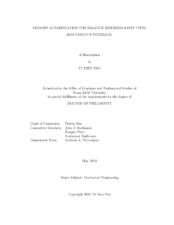| dc.description.abstract | This dissertation focuses on the development and evaluation of portable sensory augmentation systems that render skin-stretch feedback of posture for standing balance training and for postural control improvement. Falling is one of the main causes of fatal injuries among all members of the population. The high incidence of fall-related injuries also leads to high medical expenses, which cost approximately $34 billion annually in the United States. People with neurological diseases, e.g., stroke, multiple sclerosis, spinal cord injuries, and the elderly are more prone to falling when compared to healthy individuals. Falls among these populations can also lead to hip fracture, or even death. Thus, several balance and gait rehabilitation approaches have been developed to reduce the risk of falling. Traditionally, a balance-retraining program includes a series of exercises for trainees to strengthen their sensorimotor and musculoskeletal systems. Recent advances in technology have incorporated biofeedback such as visual, auditory, or haptic feedback to provide the users with extra cues about their postural sway. Studies have also demonstrated the positive effects of biofeedback on balance control. However, current applications of biofeedback for interventions in people with impaired balance are still lacking some important characteristics such as portability (in-home care), small-size, and long-term viability. Inspired by the concept of light touch, a light, small, and wearable sensory augmentation system that detects body sway and supplements skin stretch on one’s fingertip pad was first developed. The addition of a shear tactile display could significantly enhance the sensation to body movement. Preliminary results have shown that the application of passive skin stretch feedback at the fingertip enhanced standing balance of healthy young adults. Based on these findings, two research directions were initiated to investigate i) which dynamical information of postural sway could be more effectively conveyed by skin stretch feedback, and ii) how can such feedback device be easily used in the clinical setting or on a daily basis. The major sections of this research are focused on understanding how the skin stretch feedback affects the standing balance and on quantifying the ability of humans to interpret the cutaneous feedback as the cues of their physiological states. Experimental results from both static and dynamic balancing tasks revealed that healthy subjects were able to respond to the cues and subsequently correct their posture. However, it was observed that the postural sway did not generally improve in healthy subjects due to skin stretch feedback. A possible reason was that healthy subjects already had good enough quality sensory information such that the additional artificial biofeedback may have interfered with other sensory cues. Experiments incorporating simulated sensory deficits were further conducted and it was found that subjects with perturbed sensory systems (e.g., unstable surface) showed improved balance due to skin stretch feedback when compared to the neutral standing conditions. Positive impacts on balance performance have also been demonstrated among multiple sclerosis patients when they receive skin stretch feedback from a sensory augmentation walker. The findings in this research indicated that the skin stretch feedback rendered by the developed devices affected the human balance and can potentially compensate underlying neurological or musculoskeletal disorders, therefore enhancing quiet standing postural control. | en |


